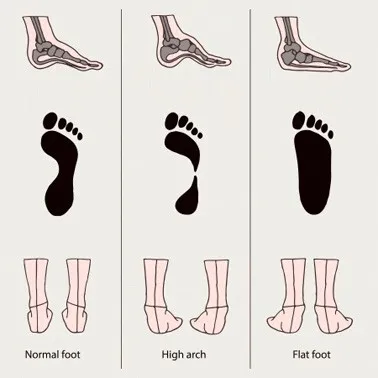Tips & Advice From Dr Frank Henry, DPM - Marble Falls

Flat Feet and High Arches: Finding Support for Every Foot
Our feet are the unsung heroes of our daily lives, carrying us through countless steps and activities. But what happens when the natural arch of the foot deviates from the norm? We're talking about flat feet and high arches, two common conditions that can lead to discomfort and even pain. The good news is that many non-surgical treatment options can help alleviate symptoms and improve foot function.
Understanding the Arch: A Foundation for Movement
The arch of the foot, that curved structure along the bottom, plays a crucial role in shock absorption, weight distribution, and propulsion during walking and running. A healthy arch provides flexibility and stability. However, when the arch is too low (flat feet) or too high (high arches), these functions can be compromised.
Flat Feet (Pes Planus): When the Arch Collapses
Flat feet occur when the arch of the foot flattens, causing the entire sole to come into contact with the ground. This can be congenital (present from birth) or acquired later in life due to factors like injury, aging, or certain medical conditions.
Symptoms of Flat Feet:
Foot pain, especially in the heel and arch
Swelling in the ankle
Tired or achy feet after prolonged standing or walking
Difficulty with certain activities
Changes in gait
High Arches (Pes Cavus): When the Arch is Exaggerated
High arches, on the other hand, are characterized by an excessively high arch that doesn't flatten during weight-bearing. This can lead to increased pressure on the heel and ball of the foot. High arches can also be caused by neurological conditions or inherited structural issues.
Symptoms of High Arches:
Heel pain
Ball of foot pain
Ankle instability
Hammertoes or claw toes
Calluses on the heel, ball of the foot, and toes
Non-Surgical Treatment Options: Finding Relief Without the Knife
Fortunately, many individuals with flat feet or high arches can find relief through non-surgical interventions. Here are some common approaches:
Orthotics: Custom-made or over-the-counter orthotic inserts can provide arch support, improve foot alignment, and cushion the foot. Orthotics are often the first line of treatment for both flat feet and high arches.
Stretching and Exercises: Specific stretches and exercises can strengthen the muscles in the foot and ankle, improving flexibility and stability. For flat feet, exercises focusing on arch support are key. For high arches, stretching the calf muscles and plantar fascia can be beneficial.
Physical Therapy: A physical therapist can develop a personalized exercise program to address your specific needs and teach you proper foot mechanics.
Supportive Footwear: Wearing shoes with good arch support, cushioning, and stability is crucial. Avoid high heels and flat shoes with minimal support.
Weight Management: Maintaining a healthy weight can reduce stress on the feet and alleviate symptoms.
Lifestyle Modifications: Avoiding activities that exacerbate pain and taking regular breaks to rest your feet can help manage symptoms.
When to See a Doctor
While many cases of flat feet and high arches can be managed with non-surgical treatment, it's essential to seek professional medical advice if:
You experience persistent foot pain.
Your symptoms interfere with your daily activities.
You notice changes in the shape or function of your feet.
You have other medical conditions, such as diabetes or arthritis.
A podiatrist or orthopedic specialist can evaluate your condition, determine the underlying cause, and recommend the most appropriate treatment plan.
A personalized treatment plan is crucial for addressing these structural issues and preventing future complications. Consider consulting with Frank Henry, DPM in Marble Falls, TX, for a comprehensive evaluation and to discuss a tailored treatment approach for your specific arch type. This plan may include options such as custom orthotics, targeted exercises, or other interventions designed to provide proper support, improve biomechanics, and enhance your overall comfort and mobility.
Finding Your Footing for a Healthier You
Flat feet and high arches don't have to hold you back. By understanding your condition and exploring non-surgical treatment options, you can take steps towards healthier, happier feet and a more active lifestyle. Remember, every foot is unique, and finding the right approach for you is key to long-term comfort and well-being.
If you have any questions, please feel free to contact our office located in Marble Falls, TX . We offer the newest diagnostic and treatment technologies for all your foot care needs.
Ask Dr Frank Henry, DPM - Marble Falls And His Team
Fill in the form to request a Call From Our Team
One of our team members will call you for FREE and answer any questions or concerns you may have about your condition




